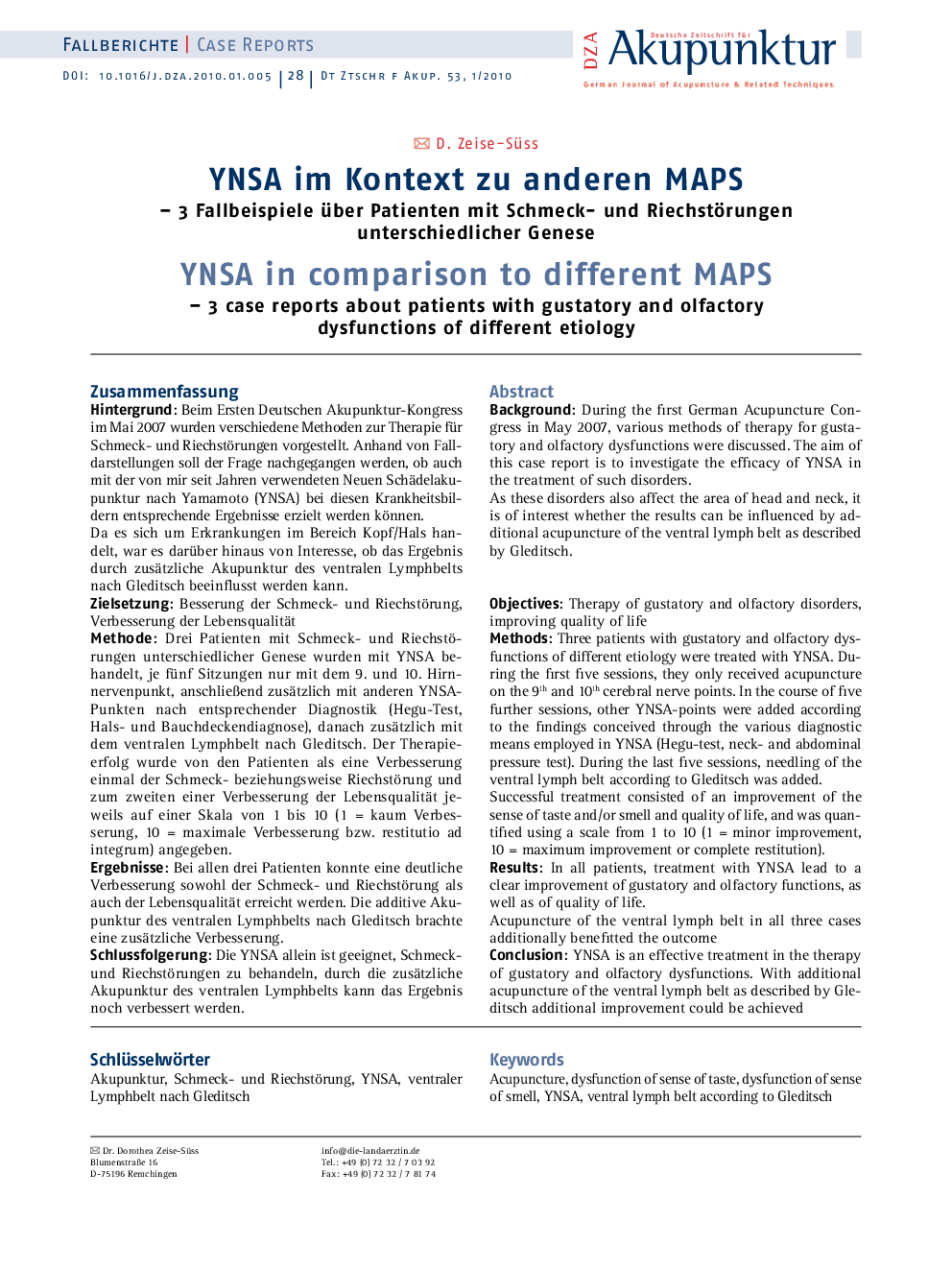| کد مقاله | کد نشریه | سال انتشار | مقاله انگلیسی | نسخه تمام متن |
|---|---|---|---|---|
| 2616245 | 1135165 | 2010 | 6 صفحه PDF | دانلود رایگان |

ZusammenfassungHintergrundBeim Ersten Deutschen Akupunktur-Kongress im Mai 2007 wurden verschiedene Methoden zur Therapie für Schmeck- und Riechstörungen vorgestellt. Anhand von Falldarstellungen soll der Frage nachgegangen werden, ob auch mit der von mir seit Jahren verwendeten Neuen Schädelakupunktur nach Yamamoto (YNSA) bei diesen Krankheitsbildern entsprechende Ergebnisse erzielt werden können.Da es sich um Erkrankungen im Bereich Kopf/Hals handelt, war es darüber hinaus von Interesse, ob das Ergebnis durch zusätzliche Akupunktur des ventralen Lymphbelts nach Gleditsch beeinflusst werden kann.ZielsetzungBesserung der Schmeck- und Riechstörung, Verbesserung der LebensqualitätMethodeDrei Patienten mit Schmeck- und Riechstörungen unterschiedlicher Genese wurden mit YNSA behandelt, je fünf Sitzungen nur mit dem 9. und 10. Hirnnervenpunkt, anschließend zusätzlich mit anderen YNSA-Punkten nach entsprechender Diagnostik (Hegu-Test, Hals- und Bauchdeckendiagnose), danach zusätzlich mit dem ventralen Lymphbelt nach Gleditsch. Der Therapieerfolg wurde von den Patienten als eine Verbesserung einmal der Schmeck- beziehungsweise Riechstörung und zum zweiten einer Verbesserung der Lebensqualität jeweils auf einer Skala von 1 bis 10 (1 = kaum Verbesserung, 10 = maximale Verbesserung bzw. restitutio ad integrum) angegeben.ErgebnisseBei allen drei Patienten konnte eine deutliche Verbesserung sowohl der Schmeck- und Riechstörung als auch der Lebensqualität erreicht werden. Die additive Akupunktur des ventralen Lymphbelts nach Gleditsch brachte eine zusätzliche Verbesserung.SchlussfolgerungDie YNSA allein ist geeignet, Schmeck- und Riechstörungen zu behandeln, durch die zusätzliche Akupunktur des ventralen Lymphbelts kann das Ergebnis noch verbessert werden.
BackgroundDuring the first German Acupuncture Congress in May 2007, various methods of therapy for gustatory and olfactory dysfunctions were discussed. The aim of this case report is to investigate the efficacy of YNSA in the treatment of such disorders.As these disorders also affect the area of head and neck, it is of interest whether the results can be influenced by additional acupuncture of the ventral lymph belt as described by Gleditsch.ObjectivesTherapy of gustatory and olfactory disorders, improving quality of lifeMethodsThree patients with gustatory and olfactory dysfunctions of different etiology were treated with YNSA. During the first five sessions, they only received acupuncture on the 9th and 10th cerebral nerve points. In the course of five further sessions, other YNSA-points were added according to the findings conceived through the various diagnostic means employed in YNSA (Hegu-test, neck- and abdominal pressure test). During the last five sessions, needling of the ventral lymph belt according to Gleditsch was added.Successful treatment consisted of an improvement of the sense of taste and/or smell and quality of life, and was quantified using a scale from 1 to 10 (1 = minor improvement, 10 = maximum improvement or complete restitution).ResultsIn all patients, treatment with YNSA lead to a clear improvement of gustatory and olfactory functions, as well as of quality of life.Acupuncture of the ventral lymph belt in all three cases additionally benefitted the outcomeConclusionYNSA is an effective treatment in the therapy of gustatory and olfactory dysfunctions. With additional acupuncture of the ventral lymph belt as described by Gleditsch additional improvement could be achieved
Journal: Deutsche Zeitschrift für Akupunktur - Volume 53, Issue 1, 2010, Pages 28–33